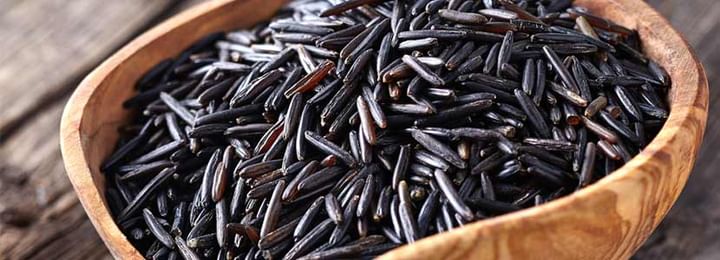Benefits of Wild Rice And Its Side Effects
Last Updated: Jul 02, 2020
The health benefits of Wild rice are such that it helps in optimizing digestion, boosts the immunity, promotes growth and repair helps in improving bone strength, prevents birth defects, helps in weight loss, prevents chronic diseases, natural treatment for Osteoporosis, helps to protect the heart, helps in preventing aging, is a super food for those in gluten free diet and helps in preventing macular degeneration.
Wild Rice
Wild rice are four species of grasses forming the genus Zizania, and the grain can be harvested from them. The grain was historically gathered and eaten in both North America and China. While now a delicacy in North America, the grain is eaten less in China, where the plant's stem is used as a vegetable.
Wild rice is not directly related to Asian rice (Oryza sativa), whose wild progenitors are O. rufipogon and O. nivara, although they are close cousins, sharing the tribe Oryzeae.
Wild rice grains have a chewy outer sheath with a tender inner grain that has a slightly vegetal taste. The plants grow in shallow water in small lakes and slow-flowing streams. Often, only the flowering head of wild rice rises above the water. The grain is eaten by dabbling ducks and other aquatic wildlife, as well as by humans.
Nutritional Value of Wild Rice
One cup of cooked wild rice contains about :
Nutritional facts Per 100 Grams
Vitamins and Minerals
Health Benefits of Wild Rice
Helps in optimizing digestion
Wild rice boasts an impressive amount of dietary fibre. Apart from optimizing the cholesterol balance, the fibre also bulks up the stool and eases the digestive process. By facilitating peristalsis, dietary fibre can help to eliminate constipation, diarrhoea, bloating, cramping, and excess flatulence, as well as more serious gastrointestinal concerns, such as colorectal cancer, gastric ulcers, and haemorrhoids.
Helps in boosting the immunity
Improving the health of a person’s immune system is one of the best ways to increase their overall health. One of the best ways to get that immunity boost is with vitamin C, which is significantly present in wild rice.
Vitamin C stimulates the production of white blood cells, the body’s first line of defence against foreign agents, pathogens, and microbes. Furthermore, vitamin C is a critical component of collagen, which is needed for the creation and repair of cells, organs, tissues, and blood vessel walls, helping us recover from illnesses.
Promotes growth and repair
The high protein content found in wild rice can be good for increasing muscle mass, proper growth, and balanced development in the human body. Proteins are made up of the building blocks of life that are the amino acids, so adequate protein levels are essential for overall health, and wild rice is a great option for that, particularly for vegetarians who don’t regularly get animal proteins in their diet.
Helps in improving bone strength
With age, human bodies begin to break down, including the bones. In order to maintain strong bones, intake of phosphorus-rich foods like wild rice can be very helpful. Phosphorous and zinc are important for maintaining bone mineral density and ensuring strong bones and joints with aging. If a person is susceptible to osteoporosis or is already starting to feel those aches in the bones, switching over to wild rice is a wise option.
Prevents birth defects
Wild rice has significant levels of vitamins, including vitamin B6, also known as folate or folic acid, and this has been proven to reduce neural tube defects in newborns. Expectant mothers should add wild rice to their diet for all of its important health benefits, but particularly if they aren’t getting a proper B-vitamin fix every day.
Helps in weight loss
As a low-calorie and gluten-free food, wild rice can help those who are attempting to lose weight and prevent obesity. Unlike white rice, which can bulk up a person’s diet and actually help gain weight, wild rice has a different effect, preventing overeating due to high fibre and nutrient content, without supplying a high level of calories to the bones. One way to overcome this is with a fair balance of essential minerals in our diet, which wild rice can provide.
Helps in preventing chronic diseases
Although the research on chronic diseases takes years of time for solid results to be publicly accepted, The antioxidants in wild rice have been shown to lower the chances of certain chronic disease conditions, including heart-related disorders, diabetes, and even some types of cancer. This is due to the neutralizing effect on the dangerous free radicals.
Natural Treatment for Osteoporosis
Osteoporosis can be suffered by anyone. Though there are a lot of modern medications today to treat osteoporosis but nothing could compare the natural treatment. Wild rice is well known to be having some healing properties that could treat osteoporosis naturally especially the minerals compounds found in this type of rice.
Helps to protect the heart
Wild rice certainly contains nutrients that help to boost the heart health. There is no sodium in wild rice, which helps to reduce blood pressure, but at same time there is a high level of fibre, which is known to clear out “bad” cholesterol from the cardiovascular system and reduce the chances of developing atherosclerosis. By eliminating the strain on the heart, and boosting repair and damage control with a high level of vitamin C, wild rice is a clear choice for those who want to protect their heart.
Helps in preventing aging
Wild rice contains an impressive level of antioxidants. Antioxidants neutralize free radicals, the dangerous by-products of cellular metabolism that can cause healthy cells to mutate or turn cancerous. This includes the free radicals that accumulate in the skin and can contribute to signs of aging, such as wrinkles, age spots, and slower healing of blemishes. This is also true for the ocular cells, and antioxidants can prevent macular degeneration and the onset of cataracts.
Super Food for those in gluten free diet
Gluten free diet has been proven to have a lot of health benefits. People in gluten free diet sometimes find it difficult to fulfill some nutrient’s daily intake but now wild rice is more than enough to provide the nutrient’s daily intake required by body. That is why wild rice is considered to be one of those super foods for gluten free diet follower.
Helps in Preventing Macular Degeneration
Any food which is rich in antioxidants has the ability to prevent macular degeneration conditions. During senior age sometimes it is difficult to deal with this condition but by starting healthy lifestyle as early as possible could prevent this condition to occur. Consuming wild rice regularly can to control eye problem and bone fracture which occurs with aging.
Uses of Wild Rice
Wild rice is used in a wide variety of foods such as dressings, casseroles, soups, salads, and desserts. In recent years, wild rice has been used in breakfast cereals, and mixes for pancakes, muffins, and cookies. Blends of wild rice and long-grain regular rice (Oryza) that were introduced in the early 1960s increased the popularity of wild rice among consumers. Wild rice from natural stands is popular among health-food enthusiasts.
Side Effects of Wild Rice
Wild rice is generally safe for human consumption. However, in some cases it may be contaminated with ergot or heavy metals.
Wild rice seeds can be infected with a toxic fungus called ergot, which may be dangerous if eaten. Some side effects of ergot toxicity include nausea, vomiting, diarrhoea, headaches, dizziness, seizures and mental impairment.
Similarly to regular rice, wild rice may contain heavy metals. Over time, heavy metals can accumulate in the body and cause health problems.
Cultivation of Wild Rice
Wild rice (Zizania palustris L.) is native to North America and grows predominantly in the Great Lakes region. This large-seeded species, one of four species of wild rice, is in the grass family (Poaceae) and has been eaten by people since prehistoric times. Early North American inhabitants, especially the Ojibway, Menomini, and Cree tribes in the North Central region of the continent, used the grain as a staple food and introduced European fur traders to wild rice.
Manomio, the name they gave wild rice, means good berry. Early English explorers called this aquatic plant wild rice or Indian rice, while the French saw a resemblance to oats and called it folle avoine. Other names given to wild rice include Canadian rice, squaw rice, water oats, blackbird oats, and marsh oats. However, the name 'wild rice' persisted and today it is the common name for the genus Zizania, even though the wild type of rice (Oryza) is also called wild rice.
Prior to 1965 most wild rice in the United States was produced in natural stands in lakes, rivers, and streams. In Canada most wild rice is still produced in lakes and streams that are leased from the government. Growing wild rice as a field crop was first suggested in 1852 by Joseph Bowron from Wisconsin, and in 1853 by Oliver H. Kelley of Minnesota.
Efforts to grow wild rice as a field crop did not begin until 1950. James and Gerald Godward grew wild rice in a one-acre diked, flooded field (paddy) near Merrifield, Minnesota. By 1958 they had 120 acres of paddies for growing wild rice. Additional growers started paddy production during the mid-1950s and early 1960s, and in 196S, Uncle Ben, Inc. started contracting acreages. These initial efforts to commercialize wild rice production resulted in an organized effort to domesticate this crop using plant breeding.
References
- Surendiran G, Alsaif M, Kapourchali FR, Moghadasian MH. Nutritional constituents and health benefits of wild rice (Zizania spp.). Nutrition reviews. 2014 Apr 1;72(4):227-36. [Cited 26 June 2019]. Available from:
- Watts BM, Dronzek BL. Chemical composition of wild rice grain. Canadian journal of plant science. 1981 Apr 1;61(2):437-46. [Cited 26 June 2019]. Available from:
- Anwar F, Zengin G, Alkharfy KM, Marcu M. Wild rice (Zizania sp.): A potential source of valuable ingredients for nutraceuticals and functional foods. Riv. Ital. Sostanze Gr. 2017;565:81-9. [Cited 26 June 2019]. Available from:
Table of content
Ask a free question
Get FREE multiple opinions from Doctors



